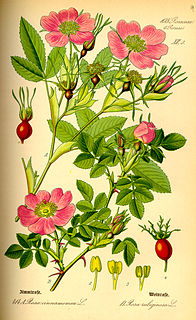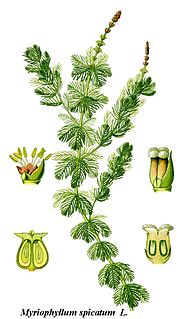
The Malpighiales comprise one of the largest orders of flowering plants, containing about 36 families and more than 16,000 species, about 7.8% of the eudicots. The order is very diverse, containing plants as different as the willow, violet, poinsettia, manchineel, rafflesia and coca plant, and are hard to recognize except with molecular phylogenetic evidence. It is not part of any of the classification systems based only on plant morphology. Molecular clock calculations estimate the origin of stem group Malpighiales at around 100 million years ago (Mya) and the origin of crown group Malpighiales at about 90 Mya.

Rosales is an order of flowering plants. It is sister to a clade consisting of Fagales and Cucurbitales. It contains about 7,700 species, distributed into about 260 genera. Rosales comprise nine families, the type family being the rose family, Rosaceae. The largest of these families are Rosaceae (90/2500) and Urticaceae (54/2600). The order Rosales is divided into three clades that have never been assigned a taxonomic rank. The basal clade consists of the family Rosaceae; another clade consists of four families, including Rhamnaceae; and the third clade consists of the four urticalean families.

The Saxifragales (saxifrages) are an order of flowering plants (Angiosperms). They are an extremely diverse group of plants which include trees, shrubs, perennial herbs, succulent and aquatic plants. The degree of diversity in terms of vegetative and floral features makes it difficult to define common features that unify the order.

The Nymphaeales are an order of flowering plants, consisting of three families of aquatic plants, the Hydatellaceae, the Cabombaceae, and the Nymphaeaceae. It is one of the three orders of basal angiosperms, an early-diverging grade of flowering plants. At least 10 morphological characters unite the Nymphaeales. One of the traits is the absence of a vascular cambium, which is required to produce both xylem (wood) and phloem, which therefore are missing. Molecular synapomorphies are also known.

Monocotyledons, commonly referred to as monocots, are grass and grass-like flowering plants (angiosperms), the seeds of which typically contain only one embryonic leaf, or cotyledon. They constitute one of the major groups into which the flowering plants have traditionally been divided; the rest of the flowering plants have two cotyledons and are classified as dicotyledons, or dicots.

Hamamelidaceae, commonly referred to as the witch-hazel family, is a family of flowering plants in the order Saxifragales. The clade consists of shrubs and small trees positioned within the woody clade of the core Saxifragales. An earlier system, the Cronquist system, recognized Hamamelidaceae in the Hamamelidales order.

The Canellaceae are a family of flowering plants in the order Canellales. The order includes only one other family, the Winteraceae. Canellaceae is native to the Afrotropical and Neotropical realms. They are small to medium trees, rarely shrubs, evergreen and aromatic. The flowers and fruit are often red.

Saxifragaceae is a family of herbaceous perennial flowering plants, within the core eudicot order Saxifragales. The taxonomy of the family has been greatly revised and the scope much reduced in the era of molecular phylogenetic analysis. The family is divided into ten clades, with about 640 known species in about 35 accepted genera. About half of these consist of a single species, but about 400 of the species are in the type genus Saxifraga. The family is predominantly distributed in the northern hemisphere, but also in the Andes in South America.

Ochnaceae is a family of flowering plants in the order Malpighiales. In the APG III system of classification of flowering plants, Ochnaceae is defined broadly, to include about 550 species, and encompasses what some taxonomists have treated as the separate families Medusagynaceae and Quiinaceae. In a phylogenetic study that was published in 2014, Ochnaceae was recognized in the broad sense, but two works published after APG III have accepted the small families Medusagynaceae and Quiinaceae. These have not been accepted by APG IV (2016).

The Limnanthaceae are a small family of annual herbs occurring throughout temperate North America. There are eight species and nineteen taxa currently recognized. Members of this family are prominent in vernal pool communities of California. Some taxa have been domesticated for use as an oil seed crop. Some members are listed as threatened or endangered and have been the focus of disputes over development plans

Parnassiaceae Gray were a family of flowering plants in the eudicot order Celastrales. The family is not recognized in the APG III system of plant classification. When that system was published in 2009, Parnassiaceae were treated as subfamily Parnassioideae of an expanded family Celastraceae.

The rosids are members of a large clade of flowering plants, containing about 70,000 species, more than a quarter of all angiosperms.

Abrophyllum is a monotypic genus of flowering plants in the family Saxifragaceae sensu lato according to Engler, A. in Engler & Prantl and Schulze-Menz, G. K. in Melchior, 1964; placed in Subfamily Escallonioideae, Tribe Cuttsieae, it is closely related to Cuttsia. In the APG II system Abrophyllum is placed in family Rousseaceae.

Peridiscaceae is a family of flowering plants in the order Saxifragales. Four genera comprise this family: Medusandra, Soyauxia, Peridiscus, and Whittonia., with a total of 12 known species. It has a disjunct distribution, with Peridiscus occurring in Venezuela and northern Brazil, Whittonia in Guyana, Medusandra in Cameroon, and Soyauxia in tropical West Africa. Whittonia is possibly extinct, being known from only one specimen collected below Kaieteur Falls in Guyana. In 2006, archeologists attempted to rediscover it, however, it proved unsuccessful.

Huerteales is the botanical name for an order of flowering plants. It is one of the 17 orders that make up the large eudicot group known as the rosids in the APG III system of plant classification. Within the rosids, it is one of the orders in Malvidae, a group formerly known as eurosids II and now known informally as the malvids. This is true whether Malvidae is circumscribed broadly to include eight orders as in APG III, or more narrowly to include only four orders. Huerteales consists of four small families, Petenaeaceae, Gerrardinaceae, Tapisciaceae, and Dipentodontaceae.

Haloragaceae is a eudicot flowering plant family in the order Saxifragales, based on the phylogenetic APG system. In the Cronquist system, it was included in the order Haloragales.

Penthorum is a genus of plants in the order Saxifragales. They are erect herbaceous perennials about half a meter tall. The genus consists of two species, one from east Asia and one from eastern North America. It is variously classified in the family Saxifragaceae or its own family Penthoraceae. Its closest relatives may be in Haloragaceae.
Lepuropetalon is a genus of flowering plants in the family Celastraceae. Before it was placed in the family when it was defined by the Angiosperm Phylogeny Group's APG III system in 2009, it had been placed with Parnassia in the family Parnassiaceae, now usually treated as a segregate of Celastraceae. When their most recent revision of Angiosperm classification was published in 2016, it retained its position in the family Celastraceae. Lepuropetalon has only one species, Lepuropetalon spathulatum. It is a winter annual that is most abundant in eastern Texas and western Louisiana. From there, it occurs sporadically southward into Mexico, and eastward through the Atlantic and Gulf coastal plain, and rarely in the Piedmont Plateau, to North Carolina. It has a disjunct distribution. In addition to the area mentioned above, it is also found in Uruguay and central Chile.
When the APG II system of plant classification was published in April 2003, fifteen genera and three families were placed incertae sedis in the angiosperms, and were listed in a section of the appendix entitled "Taxa of uncertain position".

















